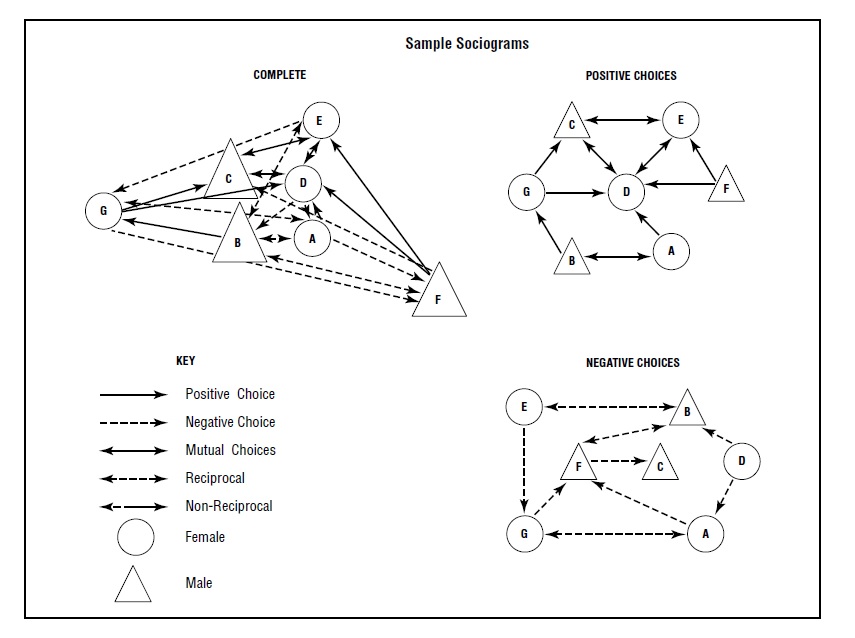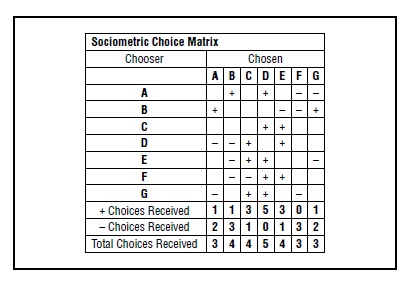This sample Sociometry Research Paper is published for educational and informational purposes only. If you need help writing your assignment, please use our research paper writing service and buy a paper on any topic at affordable price. Also check our tips on how to write a research paper, see the lists of research paper topics, and browse research paper examples.
Sociometry, by definition, measures the “socius”—the interpersonal connection between two people (Moreno 1951). The founder of sociometry, Jacob L. Moreno (1889-1974), conceived three levels of sociometry (Moreno [1953] 1993), applying the term sociometry to each (tending to cause confusion). These levels are:
Theoretical system (alternately termed sociatry)— including role, social atom, spontaneity/encounter, psychodrama/enactment, and sociometry theories; subtheory of that system; and assessment method and intervention (Hale 1981; Remer 2006).
Historically sociometry was a central influence in sociology and related areas, even producing several dedicated journals. Over time, though, its influence has diminished to such a point that, at most, one of its central constructs—the sociogram—gets only passing mention in assessment texts (e.g., Cohen and Swerdlik 2005; Cronbach 1970; Gronlund 1971). However, a complete understanding of sociometry provides tremendously powerful structures and tools for use not only in small group interactions but also wherever and whenever interpersonal dynamics come into play.
Grasping the entire sociometric system is optimal, but popularly sociometry theory is focused on measuring relationships, the purview of both social atom theory (long-term relationships and their development and maintenance over time) and sociometry (fluctuation of interpersonal connections over short periods). The sociogram is the representation of sociometry (see Figure 1).
Beyond the conception of humans as essentially social beings, sociometry recognizes and uses the fact that all these connections are perpetually manifest in the social choices we make—for example, with whom we eat lunch; whom we marry; whom we sit next to in classes, receptions, and other meetings; whom we like and do not like (based on tele, warm-up, role reciprocity). Using both positive (choose/acceptance/attraction) and negative (not-choose/rejection/repulsion) choices, the connections between people and the patterns of connections throughout groups are made manifest, explored, and influenced (Remer 1995a, 1995b; Remer and Finger 1995; Remer, Lima, Richey, et al. 1995).
The key to using sociometry as an assessment and intervention (like Heisenberg’s principle) most effectively is understanding Moreno’s full conceptualization. The misconception is that sociometry stops with the production of the sociogram from choices expressed related to a specific criterion (e.g., “With whom would you most and least want to sit at a wedding reception?”). This level is what Moreno called “near [‘weak’] sociometry” (my label). “Strong” sociometry requires two conditions beyond eliciting choices and depicting them: (1) The choices must be implemented (e.g., you must sit with whom you have chosen), and (2) the reasons for choosing must be made overt and explored. The last two conditions present many possibilities and difficulties.
Implementing the choices makes them real in the sense that the full impact of a choice is experienced (e.g., you can say I’ll sit with Aunt Bertha to be nice, but actually sitting with her may inform you fully why others have not opted for that seat). So future choices will be influenced. Arriving at an optimal implementation is challenging because not everyone can have one of his or her positives, and some must endure a negative—regardless of how many selections are allowed (a phenomenon addressed by the theory).
Examining choice rationales presents other challenges. People tend to be uncomfortable with the process because, for example, they believe that feelings may be hurt or they are confused by their own ambivalences and lack of awareness of their reasons. Reservations have some validity but usually not nearly to the degree feared. The benefit derives from probing projections attendant— assumptions about the rationales and/or expectations for the choices. At worst, some perceptions are confirmed; at best and more often, the rationales do not conform to suppositions in informative ways (e.g., you are not chosen by a friend because you see each other frequently and he or she wants to visit with others, or you are chosen by someone because you are seen as the only less talkative person in the group). Negatives are not necessarily “bad,” nor are positives necessarily “good.” Learning reasons challenges assumptions and/or provides the basis for changing behaviors—a not inconsequential therapeutic value.

Figure 1
The sociograms (Figure 1) and the choices from which it is constructed (Figure 2) clarify these points and introduce terminology to illustrate the strengths of sociometry. The data are real, using the criterion “From whom would you like feedback?” based on two positive and two negative choices.
The pattern of choices shows that D is the “star” (that is, he or she receives the most choices) and F is a “rejectee” (he or she receives no positive choices and a number of negative choices); everyone else is a “member” (receiving some positive and perhaps some negative choices). No “isolate” (someone receiving no choices) appears. C, D, and E form a “subgroup,” having each reciprocally positively chosen each other. The centrality of D and F to the group dynamics is more obvious in seeing the positives and negatives separately, illustrating that energy of the group is demanded regardless of choice valence—both D and F have significant impacts.

Figure 2
The criterion implemented dyadically manifests practical difficulties. Who would be paired with D; who would be stuck with F? If C and E were paired, satisfying their desires, what then of D’s desires? The optimal implementation satisfies the most choices of either valence. The process makes manifest exactly the dynamics experienced in all group situations (as anyone planning a wedding reception can attest). Knowing the reasons behind the choices and their strength (expanded schema) can help with optimal assignment. Some rationales indicate that “violating” a choice is not as detrimental as assumed (e.g., A and G reciprocally reject because they do not know each other).
With the particular criterion used (and its converse, “To whom would you like to give feedback?”), the implementation and rationale-sharing fit well together (i.e., sharing the rationales is giving feedback). With different criteria the sociometry will change, perhaps not greatly. For example, “To whom would you like to speak?” or “Whom would you like to know better?” could change the valence of the A-G choices and also demonstrates the difference between “actionable” criteria and “near” sociometry ones (e.g., “Whom in the group don’t you know well?”). Choice of criteria influences the sociometry, revealing each individual’s worth if done skillfully.
Lest sociometry be thought to be only small-group focused, Moreno’s work with the U.S. Navy in forming more efficient and safer squads (Moreno 1951) and with the Hudson School for Girls, where cottages were formed and run sociometrically (Moreno [1953] 1993) were both large-scale sociometry interventions.
Sociometry as an assessment and intervention is a powerful tool. Sociometry the theory offers principles to predict and guide. More comprehensive and powerful, sociometry the system applies synergistically to the multiple foci and levels of human relatedness addressed by the interconnected subtheories.
Bibliography:
- Cohen, Ronald J., and Mark E. Swerdlik. 2005. Psychological Testing and Assessment. 6th ed. Boston: McGraw-Hill.
- Cronbach, Lee J. 1970. Essentials of Psychological Testing. 3rd ed. New York: Harper and Row.
- Gronlund, Norman E. 1971. Measurement and Evaluation in Teaching. 2nd ed. New York: Macmillan.
- Hale, Ann E. 1981. Conducting Clinical Sociometric Explorations: A Manual for Psychodramatists and Sociometrists. Roanoke, VA: Royal.
- Moreno, Jacob L. 1951. Sociometry, Experimental Method, and the Science of Society. Ambler, PA: Beacon House.
- Moreno, Jacob L. 1953. Sociometry: A Journal of Interpersonal Relations and Experimental Design 18 (4).
- Moreno, Jacob L. [1953] 1993. Who Shall Survive? Foundations of Sociometry, Group Psychotherapy, and Sociodrama. Student ed. Roanoke, VA: Royal.
- Remer, Rory. 1995a. Strong Sociometry: A Definition. Journal of Group Psychotherapy, Psychodrama, and Sociometry 48: 69–74.
- Remer, Rory. 1995b. Using Strong Sociometry: Some Guidelines and Techniques. Journal of Group Psychotherapy, Psychodrama, and Sociometry 48: 79–84.
- Remer, Rory. 2006. Chaos Theory Links to Morenean Theory: A Synergistic Relationship. Journal of Group Psychotherapy, Psychodrama, and Sociometry 59: 55–85.
- Remer, Rory, and Vickey S. Finger. 1995. A Comparison of the Effects of Sociometry Components on Personal and Interpersonal Growth. Journal of Group Psychotherapy, Psychodrama, and Sociometry 48: 114–117.
- Remer, Rory, Geraldo Lima, Stephen Richey, et al. 1995. Using Strong Sociometry as an Interpersonal Feedback Tool. Journal of Group Psychotherapy, Psychodrama, and Sociometry 48: 74–79.
See also:
Free research papers are not written to satisfy your specific instructions. You can use our professional writing services to buy a custom research paper on any topic and get your high quality paper at affordable price.







